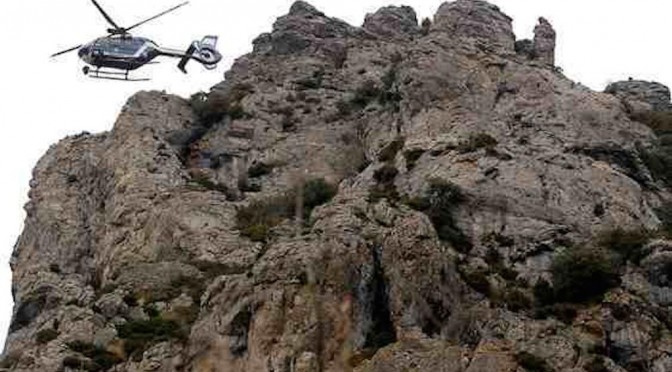The VisigothicTreasure
Family Responsibilities
 I left Rennes for the last time in 2008. My work was as complete as I could make it and I fully intended to return the following year with a T.V. or film crew and a much geophysical equipment as I could muster.
I left Rennes for the last time in 2008. My work was as complete as I could make it and I fully intended to return the following year with a T.V. or film crew and a much geophysical equipment as I could muster.However I arrived back in Australia to a crisis. My mother was by then 94 and her health was beginning to deteriorate. She pleaded with me not to “leave her” again and I acceeded to that request. My mother will be 100 years of age in August 2014. In the meantime, I have taken a course in creative writing and editing, written two books and created this web site.
Armageddon
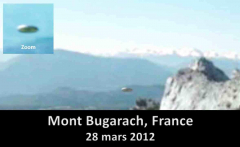 In late 2012 it seemed that everyone except me was at Bugarach. Doomsday theorists predicted that the world as we know it would come to an end. It was all mixed up with the end of the (published) Mayan calendar and the movements of planet “x”. the date set for Armageddon was December 21, which is of course the winter solstice.
In late 2012 it seemed that everyone except me was at Bugarach. Doomsday theorists predicted that the world as we know it would come to an end. It was all mixed up with the end of the (published) Mayan calendar and the movements of planet “x”. the date set for Armageddon was December 21, which is of course the winter solstice.
I did mention earlier that Bugarach is the “upside-down” mountain where the upper structure is older than the lower structure.
Some of the doomsday prophets choose Bugarach was as being the one place likely to survive and that there was a hidden “garage for UFO’s” hidden in the mountain. This picture was taken earlier in the year and is supported by a video taken by a group of Spanish climbers. There is supposed to be a second independent video from a totally different group of French climbers, but I have not been able to find it. I have watched this video many times and the Saucer does indeed seem to come “out” of the mountain. If it is a fake it is a very good one.
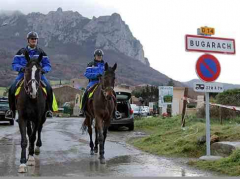 The Mayor of Bugarach complained that the village was being “overwhelmed” by visitors.
The Mayor of Bugarach complained that the village was being “overwhelmed” by visitors.
20,000 people climbed to the top of Bugarach.
The French government sent para- military police to seal off both the mountain and the village. During the reporting of these events it was often claimed that Bugarach lies on the Paris Meridien (or Meridiene Verte) which of course it doesn’t.
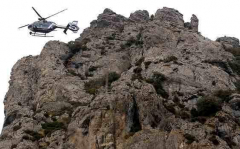 The newspapers had a field day, with photograhs of military helicopters circling the peak accompanied stories of their own helicopters being excluded.
The newspapers had a field day, with photograhs of military helicopters circling the peak accompanied stories of their own helicopters being excluded.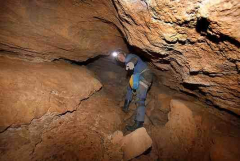 The paramilitary forces joined in the spirit of the affair , penetrating into the caves scattered around the mountain.
The paramilitary forces joined in the spirit of the affair , penetrating into the caves scattered around the mountain.
They found nothing and December 21 passed without event.
My librarian friend did not enjoy all of this. The village was overrun for several months and in December she had people camping uninvited in her garden.
The Photographers Ephemeris
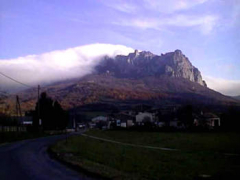 There were many excellent photographs taken under various weather conditions to give dramatic emphasis to various newspaper reports. In reading about the preparations for one series of photographs I learned of a tool called The Photographers Ephemeris (TPE).
There were many excellent photographs taken under various weather conditions to give dramatic emphasis to various newspaper reports. In reading about the preparations for one series of photographs I learned of a tool called The Photographers Ephemeris (TPE).
TPE is an application which predicts the sun’s angle at any time of the day on any day of the year, and displays the results graphically. It’s general purpose is to avoid long tips to remote locations only to find the lighting conditions unfavourable on arrival or to search for optimum conditions in a specific location without having to travel there until the day of the shoot. Knowledge that it worked effectively in exactly the area I was interested in meant that I must try it. I decided to check some of my key directions (and a couple of additional ones) using this tool.
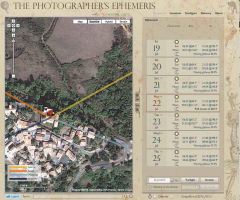 Out of curiosity the first thing I examine was the stories about the sunrise on the 22nd july (Mary Magdelene’s feast day). The tool is very easy to use for such a simple investigation.
Out of curiosity the first thing I examine was the stories about the sunrise on the 22nd july (Mary Magdelene’s feast day). The tool is very easy to use for such a simple investigation.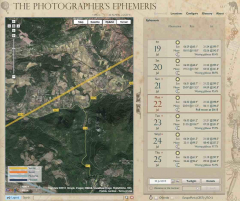 It is possible to zoom in and out and scroll without changing the location and therefore to “travel” along the line. The theory surrounding the Magdelene alignment went on to stipulate that the line of the sunrise passed over both Blanchfort and Arques. Well it does not! David Williams was right.
It is possible to zoom in and out and scroll without changing the location and therefore to “travel” along the line. The theory surrounding the Magdelene alignment went on to stipulate that the line of the sunrise passed over both Blanchfort and Arques. Well it does not! David Williams was right.The Summer Solstice
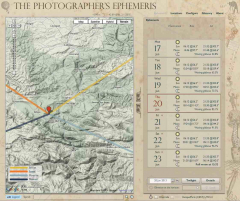 Next I created a location for Brenac within the software. By then choosing the 20th or 21st of June a line on the map was instantly provided.
Next I created a location for Brenac within the software. By then choosing the 20th or 21st of June a line on the map was instantly provided.
It is slightly disappointing. The angle given is 56.2 not 56 (33.8 north of east not 34 north of east).
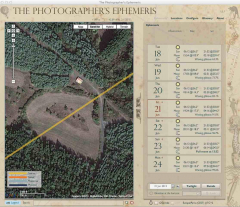 By travelling along the line the point at which it crosses the target can be examined. It crosses to the south of the apple tree.
By travelling along the line the point at which it crosses the target can be examined. It crosses to the south of the apple tree.
Examination of the days before and after the solstice shows that 56.2 is the smallest angle. A couple of days both before and after shows that the angle increases to 54.3 in both directions. When this occurs the line moves away from not towards the apple tree.
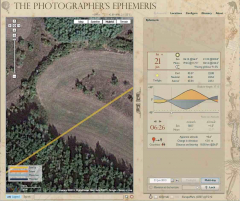 There is another feature embedded in TPE called geodetics. By positioning the small grey point ( left hand side, just below the zoom slider) on the desired target, it is possible to find the angle from the chosen base point ( in this case Brenac). As can be seen from the bottom line on the right hand side, This is indeed 56 degrees exactly. A conundrum! TPE confirms the angle to be what we expected it to be but gives reliable information that this is not actually the angle of the sunrise on the summer solstice.
There is another feature embedded in TPE called geodetics. By positioning the small grey point ( left hand side, just below the zoom slider) on the desired target, it is possible to find the angle from the chosen base point ( in this case Brenac). As can be seen from the bottom line on the right hand side, This is indeed 56 degrees exactly. A conundrum! TPE confirms the angle to be what we expected it to be but gives reliable information that this is not actually the angle of the sunrise on the summer solstice.
The Winter Solstice
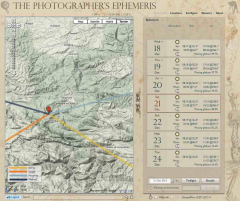 However, if we focus our attention on the southern target we find that the winter solstice at Brenac is 122 degrees exactly, which is what it supposed to be. This means the angle between the two lines is 65.8 not 66.
However, if we focus our attention on the southern target we find that the winter solstice at Brenac is 122 degrees exactly, which is what it supposed to be. This means the angle between the two lines is 65.8 not 66.
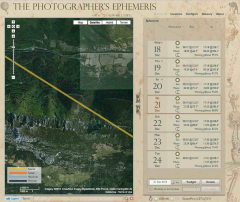 If using TPE we “travel” along the line from Brenac towards the southern target it again does not quite comply with the Google Earth construction. It is not far away but I know that mountain well enough by now to realise it can only be reached by a different set of tracks than the ones I have already explored.
If using TPE we “travel” along the line from Brenac towards the southern target it again does not quite comply with the Google Earth construction. It is not far away but I know that mountain well enough by now to realise it can only be reached by a different set of tracks than the ones I have already explored.
Carcassonne
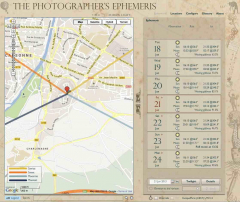 Years as a trouble shooter have taught be to think outside the box. I cannot justify or explain in any way the following jump in my thinking.
Years as a trouble shooter have taught be to think outside the box. I cannot justify or explain in any way the following jump in my thinking.
At Carcassonne, only a little to the north, the last place the treasure was seen, the summer solstice angle is indeed 56 (34 degrees north of east) and as we have just seen this line does in fact run through the apple tree. Am I concerned about such a small discrepancy? Yes. There was a very high knowledge of astronomy as far back as Stonehenge. However at some time perhaps the reference point for this whole area was Carcassonne, If so then 34 degrees could well have been taken as the correct value.
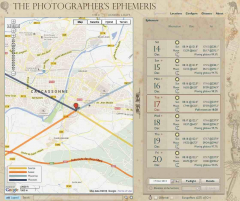 However in Carcassonne the winter solstice is 122.1. Therefore using “Carcassonne values” the angle between the two lines (122.1 – 56) would have been 66.1 instead of 66.
However in Carcassonne the winter solstice is 122.1. Therefore using “Carcassonne values” the angle between the two lines (122.1 – 56) would have been 66.1 instead of 66.
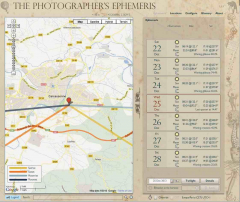 In another leap in my thinking I Searched around for a combination which would deliver the required 66 degrees, I discovered that the 25th of December met the requirements. TPE is outstanding for making these searches. Here it can be seen that on Christmas Day in Carcassonne the winter solstice is at an angle of 112.1.
In another leap in my thinking I Searched around for a combination which would deliver the required 66 degrees, I discovered that the 25th of December met the requirements. TPE is outstanding for making these searches. Here it can be seen that on Christmas Day in Carcassonne the winter solstice is at an angle of 112.1.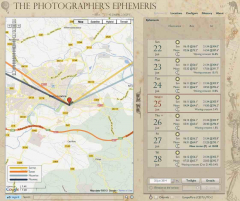 Similarly on the 25th of July the summer solstice is at an angle of 56.1. The angle between the two is exactly 66 degrees agreeing with both the numerological puzzle at Brenac, the lines emerging from the navigational study and the triangle in Saunier’s papers!
Similarly on the 25th of July the summer solstice is at an angle of 56.1. The angle between the two is exactly 66 degrees agreeing with both the numerological puzzle at Brenac, the lines emerging from the navigational study and the triangle in Saunier’s papers!
Why Christmas is Special
So what is special; about the 25th of December. Not surely that the Church of Rome decided that should be nominated as Christ’s birthday, but rather the underlying reason, why they made that decision. In fact, we have more direct knowledge about the winter solstice, than the summer solstice, because of the juxtaposition of Christmas It turns this juxtaposition is very is very relevant to the selection of the base date for the solstice.
First of all it is necessary to acknowledge that solstices are influenced by the rotation of the earth and various peculiarities in that rotation. The inaccuracy of many of the calendars over the last 2500 years have resulted in continual “drift” of the dates we use as “names” for the day of the solstice.
In the west, two calendars have been used to get a better long term match with these celestial events; the Julian and the Gregorian calendars. Any consideration is complicated by the fact that the solstice is not always on the 21st or 22nd of December. It can occur anywhere between the 20th and the 23rd. The two outer dates are relatively uncommon. The last occurrence of a solstice on the 23rd was 1903 and the next occurrence of a solstice on the 20th will be 2080.
However it is important to note that the angles of the solstace do not vary regardless of the calendar date on which the solstace occurs. At Brenac, the angles of the two solstices are always 122 and 56.2.
From this it can be seen that the calendars and therefore dates we use do not affect the celestial events which determine the point in time of each successive solstice.
Nevertheless The Julian Calendar in it’s foundation year of 46 BC, was specifically designed to set the winter solstice on the 25th December. Why?
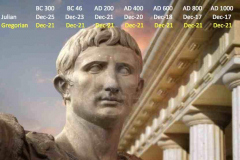
If, as shown in this diagram, December 21 in the Gregorian calendar is taken as the base, then on the date the Julian calendar replaced the old Roman calendar (46 BC) the Gregorian 21st was “called” December 23rd.
For the Romans the Julian calendar itself represented an undesirable break with tradition. If we go far enough back (BC 300 Has been chosen here) shows that in that year the 21st in the Gregorian calendar equates to 25th in the Julian Calendar.(This assume that the Julian calendar is also extrapolated backwards from the date it was created in 46 BC.) However in 46BC the gregorian 21st equated to the Julian 23rd.
This is significant because in the early days of Roman expansion a long term tradition was established in Rome that the winter solstice (known as the Bruma) co-incided with December 25th.
In fact in the old Roman calendar, before 46BC, which was only a coarse approximation to the physical year, was manipulated continually by the priests. Days were inserted or removed as they saw fit, to ensure that the Bruma always occurred on the 25th of December.
What was in any case a sacred day was claimed by many the adherents of many god’s, from Attis to Mithras to Sol Invictus as their feast or Birthday. Long before the christian era the winter solstice the shortest day, on the 25th December represented death and resurrection.
The Julian calendar regularised all this and put a stop to the yearly adjustments but was not accurate enough. It gave the desired result in the year it was introduced but by the year 1000 the Julian “name” of the time of the solstice was somewhere between the 16th and the 19th of December depending on the year. People would have become aware the something was not right!
Julian and Gregorian
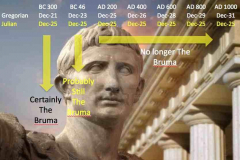 Looking at the interaction of dates from a different base, when Julius Caesar regulated the calendar in 46 BC what he called the 25 Dec was on or very close to the Bruma. It reflected his desire or those of his astronomers,to recreate an earler situation in which the date and the celestial event coincided.
Looking at the interaction of dates from a different base, when Julius Caesar regulated the calendar in 46 BC what he called the 25 Dec was on or very close to the Bruma. It reflected his desire or those of his astronomers,to recreate an earler situation in which the date and the celestial event coincided.
Over the next 200 years if the Julian calendar is compared with the backward projection of the Gregorian calendar it can be seen that the Name “December 25th” was the same in both calendars in AD 200 but in fact this was no longer the Bruma. (There has never actually been a Bruma on the Gregorian date of the 25th of December.
In the Visigothic world, specifically in Carcassonne, it is possible they would have known that the winter solstice (did they still call it the Bruma?) was supposed to be on December the 25th but would have realised the calendar was leading them astray.
However the results given in TPE are Gregorian dates and there was no knowledge of Gregorian dates before 1592 . Therefore for the TPE readings for 25th of December to have any significance they must have been picked up and used by someone with knowledge of the Gregorian calender but with sufficient ignorance to believe in the tradition that December 25th was the Winter solstace.
Therefore the solstice clue and the angle of 66 degrees must have been created at time after 1592, emphatically not the Visigothic era.
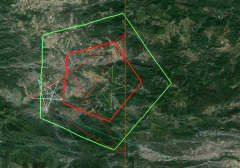
It must be stressed however that that these are the “same” lines which emerged from the construction of the “navigation solution” and the pentacles which emerged from that study. So the two targets may well have been selected during Visigothic times using derivatives of the navigation solution. All the later “clues” were simply attempts to identify the targets in a way that only initiates would be likely to discover.
Midday and Sunset
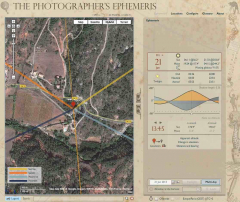 Continuing on the subject of later clues TPE encourages the explorattion of other interesting alignments
Continuing on the subject of later clues TPE encourages the explorattion of other interesting alignments
This screenshot shows not only the sun and moon lines at Poissons tomb but also the line of the sun at midday.
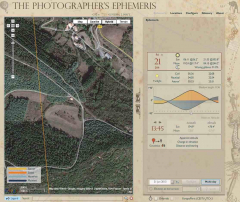 Travelling along the midday line once again takes us close to the apple tree.
Travelling along the midday line once again takes us close to the apple tree.
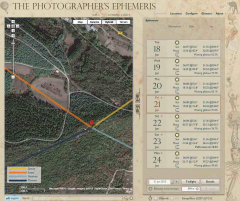 Finally the sunset line from the “sighting rock” runs directly through the apple tree.
Finally the sunset line from the “sighting rock” runs directly through the apple tree.
With all this information it would not be difficult to find the target. What, of course, is not known, until geophyisical equipment is taken to site is wether there is any treasure there!
